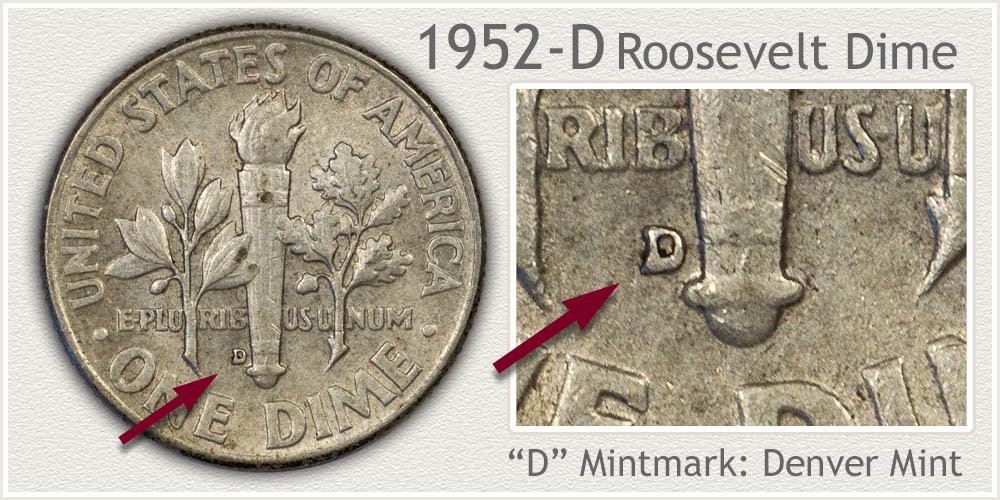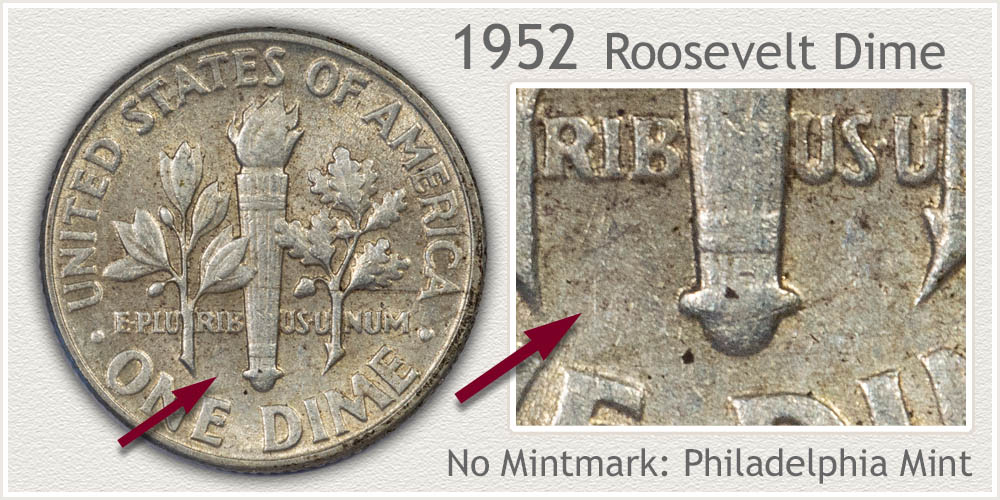Coin Values Moving with Precious Metals: Up-Dated 12/8/2025: Gold $4212 | Silver $58.12
1952 Dime Value
Silver is the start to 1952 dime value. Roosevelt dimes of the 1950's is a silver alloy, and trend with the price of precious metals. Each is currently in the range of $3.88 with a potential to higher collector premiums.
Following the same steps as collectors, mint varieties and condition are considered with an eye towards appealing qualities.

Steps Leading to Value:
- Step 1: Date and Mintmark Variety - Mint varieties are a focal point in the world of coin collecting. Each issue for a year is needed to complete sets. Identify accurately dates and mints.
- Step 2: Grading Condition - Premiums are awarded to high condition examples within the Roosevelt silver series. A close match of your coin to images of grades narrows the range on the value chart.
- Step 3: Special Qualities - Silver is the base support to values; collectors are the support to premium values. An inspection of the coin is needed to spot subtle points to collector quality dimes.
| 1952 Dime Value | ||||
|---|---|---|---|---|
| Condition of Coin | ||||
| Date | Good | Fine | Extremely Fine | Mint State |
| Roosevelt Dime Values Updated | 12/8/2025 | |||
| 1952 | $3.88 | $3.88 | $3.88 | $6.42 |
| 1952 D | $3.88 | $3.88 | $3.88 | $6.42 |
| 1952 S | $3.88 | $3.88 | $3.88 | $12.19 |
A few steps help confirms where to place your dime on the value chart. Use the images of mintmarks and grading with a close inspection of the coin. Varieties and condition are leading indicators.
Step 1: | Date and Mintmark Variety Identified
Varieties of 1952 Dimes Listed on Chart to Identify
1952 was a demanding year for the mints. The need for dimes in commerce was met with a strong increase in production. Three mints struck dimes with Denver leading the way in numbers.
Varieties of 1952 dimes are collected and valued separately. Identify your coin and its location on the chart.
1952-S Roosevelt Dime
"S" Mintmark on Reverse: San Francisco Mint Struck the Coin

San Francisco dimes are the lowest mintage of the three 1952 varieties. 44,419,000 were issued into circulation by the mint. As seen on the above chart these are a premium coin in mint state grade, no wear to the surface.
Identify the San Francisco dime by the "S" mintmark found on the reverse. Towards the bottom of the torch a small "S" is on the left side. These are a favorite with collectors. Judge yours closely in Step 2 the Grading Section.
1952-D Roosevelt Dime
"D" Mintmark on Reverse: Denver Mint Struck the Coin

Denver increased production of dimes in 1952 doubling the previous year's numbers. 122 million "D" mintmark dimes were struck. Most are valued based on their silver content, 90% silver by weight. Elite condition coins draw the attention of collectors.
Denver variety dimes of the early silver era were mint marked with a small "D" on the reverse of the coin. Inspect the left side of the torch at the base. Confirming the Denver coin is a "D" mintmark.
1952 Roosevelt Dime
No Mintmark on Reverse: Philadelphia Mint Struck the Coin

Produced in large numbers and many available today, Philadelphia 1952 dimes are first valued by silver content. Worn examples trade in a range following silver prices. A collector quality piece is noted by no wear to the surface.
Philadelphia coins are confirmed by the absence of a mintmark. On the reverse, at the base of the torch, if the left side is without a mintmark the coin was struck at Philadelphia.
Step 2: | Judging Condition Determines Grade | Narrows Value
Grading Confirms 1952 Dime Value
Most old silver Roosevelt dimes are valued as either a collectible condition coin or a bullion condition coin priced at silver. The grading process refines the judgement of condition. Examining your coin and recognizing its condition, points to a specific grade.
Subtle points are defined in the descriptions of the different grades. Add the visual example to compare your coin. This method of matching to a standard helps narrow both the grade and its place on the value chart.
Mint State Grade

Mint State: A fine texture of luster is the uppermost surface to a Mint State coin. No wear to this surface luster defines the grade. Compare closely your coin to the image to judge accurately its condition.
Highest area on the coin is the hair. All areas are covered with original luster on the example coin imaged. Notice no dulling of the metal or loss of shine. Wear causes silver to dull becoming a silver-grey tone. The bright silver-white tone is indicating no loss of metal.
Tilt your coin under a single light and while slowly moving up and down the shine flows across the surface of a mint state coin.
Extremely Fine Grade

Extremely Fine: Light wear on the high points of design defines the Extremely Fine grade. Only small amounts of metal is lost on the lightly circulated coins. Helping to identify the grade are specific areas to judge.
Roosevelt's hair contains many fine lines, both above the ear and towards the part in the hair. Each line is low in relief and beside it a high relief area. The lines remain separated in the extremely fine grade. Look closely at the area just above the ear. A flat spot is small and lines are just beginning to merge.
Overall, the hair remains well detailed and contours of high and low are well defined.
Low Grade Examples

Low Grade Condition: Noticeable wear removing a moderate amount of detail is a low grade Roosevelt dime. Coins in this condition are below extremely fine grade.
The example image displays large areas within the hair lacking any fine lines. Just above the ear is continuous flat spot from the forehead towards the back of Roosevelt's head. Heavy wear is also causing a flatness upward from the ear.
With this lack of fine details in the hair and wide areas of flatness in the cheek and jaw the condition is considered low grade.
How to Video: Grading Roosevelt Dimes
The above images help recognize and narrow a condition range. An in-depth study of grading these silver dimes is found on the following page.
Video, Images and Descriptions | Grading Roosevelt Dimes
Step 3: | Special Qualities Enhancing Value
Small Points of Quality | Inspection of Value
1952 dimes are valued in two primary categories; Mint State and Circulated conditions. These represent also the collectible quality and bullion priced conditions. Many silver dimes are very close to mint state condition and a close focus on subtle differences is needed.

In the above image the mint state dime is on the left and a just miss condition dime is on the right. Taking a moment to carefully look over each, a small amount of change in color and texture is noticed on the lightly circulated example. A couple areas on the circulated coin are inspected to confirm wear.

In the overall view a nice crisp detailed dime is presented. Lines in the hair remain bold and all facial features are well contoured. However, wear is present on the surface.
Detecting wear is the small amount of smoothing seen on the high areas, notably; cheek below the eye and neck under the ear. In the protected area near the mouth, luster is present with a fine texture over the metal. Contrast the high rounded surface of the cheek near-by. The cheek is a dull, smooth surface at its highest point, the result of slight wear.
A further inspection of the neck shows similar smoothness to the metal. Also, the high areas of the neck is a slight dull surface. Just under the ear, notice the metal is smooth and a different texture than the area closer to the chin.
When considering the condition of the high areas on Roosevelt's portrait, smooth and somewhat dull, and the bright textured metal in protected areas, a small amount of wear is judged present. The coin is below the mint state grade.
Inspect your high condition coins with an eye for the light soothing and dulling of open high areas. If these areas are without signs of wear, it becomes a collectible quality silver dime. Base silver plus subtle qualities is a premium value dime.
References
U.S. Mint. 1953 U.S. Mint Annual Report https://nnp.wustl.edu/library/book/512052
Coin Values | CoinStudy Articles
Date by Date
In Depth Roosevelt Dime Values
1946 to 1964
Roosevelt Dime Values | Early Silver Era
Roosevelt dime values of the early silver years, 1946 to 1964 are a premium coin because of silver content. These early dimes are 90% silver and move with the price of precious metals. Currently worth $3.88 each. Dates and mint varieties are listed on value charts with a step-by-step process to determine condition and how much they are worth.
Print the Coin Values Worksheet
List your Roosevelt dimes and record their values. Should you decide to sell... use the worksheet as an invoice and packing slip when sending coins through the mail to dealers. It indicates you have done your coin values homework.
Scarce and collectible dimes are found throughout the dime series. Many rare dimes are from the early mintage years. Bust dimes minted prior to 1850's are low mintage and highly sought. Seated Liberty, Barber, and Mercury dimes all have key rarities.
An insight into what is collected today, what is popular, and numbers of collectors involved helps show Roosevelt dimes are a series in demand. Coin series spanning all denominations are charted and ranked by numbers of collectors assembling sets of U.S. coins.
An easy reference guide to U.S. coin values. Charts with minimum values quickly finds starting values. Images identify the different series and dates. Links to extended charts listing varieties, grading ranges and images helping determine condition - grade of coins. On the go, bookmark to phone.
★Coin Values Discovery finds 1952 Dime Value and...
U.S. coin values determined using a step-by-step process. Begin with identifying the major coin series covering cents to gold coins. Images are used throughout to compare dates, mint varieties, special varieties, and grading condition of your coins. Follow a few steps to narrow range on value charts.
